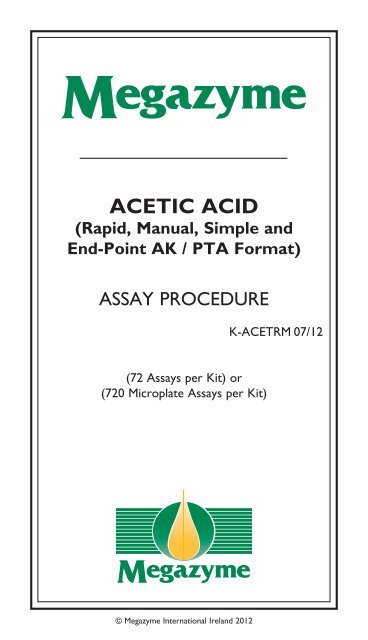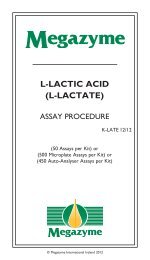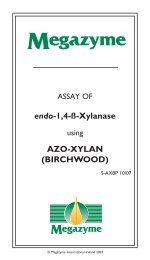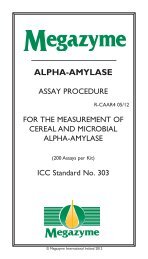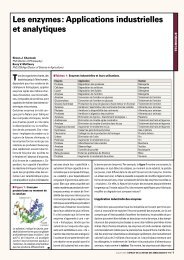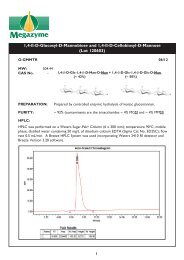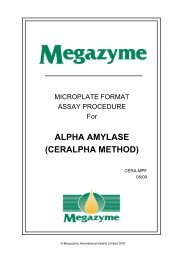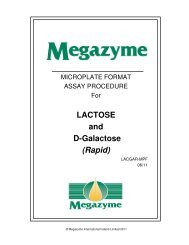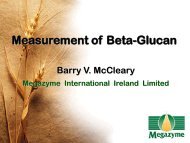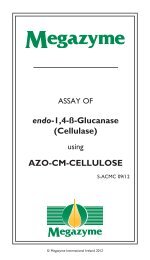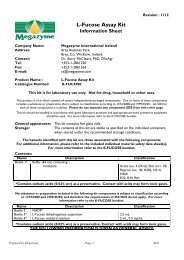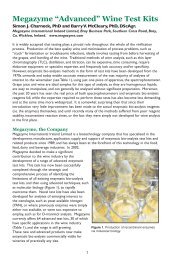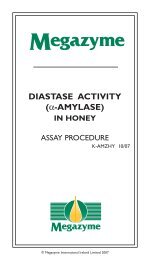ACETIC ACID - Megazyme
ACETIC ACID - Megazyme
ACETIC ACID - Megazyme
You also want an ePaper? Increase the reach of your titles
YUMPU automatically turns print PDFs into web optimized ePapers that Google loves.
<strong>ACETIC</strong> <strong>ACID</strong><br />
(Rapid, Manual, Simple and<br />
End-Point AK / PTA Format)<br />
ASSAY PROCEDURE<br />
K-ACETRM 07/12<br />
(72 Assays per Kit) or<br />
(720 Microplate Assays per Kit)<br />
© <strong>Megazyme</strong> International Ireland 2012
INTRODUCTION:<br />
Given its importance and ubiquitous occurrence in foods, beverages<br />
and other materials, acetic acid ranks amongst the most measured<br />
analytes. However, unlike some other common analytes, traditional<br />
enzymatic methods for this acid present significant limitations. For<br />
instance, manual acetyl-coenzyme A synthetase (ACS) based formats<br />
are typified by unstable reagents during use, slow reaction times,<br />
multiple cuvette additions / absorbance readings and complex<br />
calculations. While the advanced acetic acid kit (K-ACET) recently<br />
developed by <strong>Megazyme</strong> overcomes the key stability issue relating<br />
to the reconstitution of ACS for manual use, the overall format of<br />
the assay is still relatively inconvenient, requiring multiple cuvette<br />
additions and time-consuming data recording / processing.<br />
Thus <strong>Megazyme</strong> developed the current kit (K-ACETRM) based on<br />
acetate kinase (AK) and phosphotransacetylase (PTA) specifically to<br />
overcome these limitations experienced by the analyst employing<br />
manual assay procedures. Unlike ACS based kits, this product is<br />
rapid (approx. 4 min), does not present reagent stability issues,<br />
is simple to perform, has extended linearity and gives a change in<br />
absorbance stoichiometric with the concentration of acetic acid (i.e.<br />
no complex equations are required and the raw absorbance data is<br />
processed like most other enzymatic kits). In common with other<br />
<strong>Megazyme</strong> acetic acid kits, K-ACETRM also benefits from > 2 years<br />
stability during use, as the key enzyme components are supplied as<br />
ready-to-use ammonium sulphate suspensions. Polyvinylpyrrolidone<br />
(PVP) has also been incorporated into the assay system to prevent<br />
interference from particular tannins found in wines (especially red<br />
wines). As the pH (7.4) of the buffer system employed is significantly<br />
lower than in traditional ACS based kits (8.4), interference from<br />
spontaneous ester hydrolysis (causing creep reactions) is also<br />
minimised.<br />
PRINCIPLE:<br />
Acetate kinase (AK) in the presence of ATP converts acetic acid<br />
(acetate) into acetyl-phosphate and adenosine-5’-diphosphate (ADP)<br />
(1).<br />
(AK)<br />
(1) Acetic acid + ATP acetyl-phosphate + ADP<br />
This reaction is significantly accelerated by the rapid conversion<br />
of the acetyl-phosphate product into acetyl-CoA and inorganic<br />
phosphate, by the action of phosphotransacetylase (PTA) in the<br />
presence of coenzyme A (CoA) (2).<br />
1
(PTA)<br />
(2) Acetyl-phosphate + CoA acetyl-CoA + Pi<br />
The ADP formed in (1) is reconverted into ATP and pyruvate, by<br />
phosphoenolpyruvate (PEP) in the presence of pyruvate kinase (PK)<br />
(3).<br />
(PK)<br />
(3) ADP + PEP pyruvate + ATP<br />
In the presence of the enzyme D-lactate dehydrogenase (D-LDH),<br />
pyruvate is reduced to D-lactate by reduced nicotinamide-adenine<br />
dinucleotide (NADH) with the production of NAD + (4).<br />
(D-LDH)<br />
(4) Pyruvate + NADH D-lactic acid + NAD +<br />
The amount of NAD + formed in the above reaction pathway<br />
is stoichiometric with the amount of acetic acid. It is NADH<br />
consumption which is measured by the decrease in absorbance at<br />
340 nm.<br />
SPECIFICITY, SENSITIVITY, LINEARITY AND<br />
PRECISION:<br />
The assay is specific for acetic acid.<br />
The smallest differentiating absorbance for the assay is 0.005<br />
absorbance units. This corresponds to 0.063 mg of acetic acid/L of<br />
sample solution at the maximum sample volume of 2.00 mL (or to<br />
1.27 mg/L with a sample volume of 0.1 mL). The detection limit is<br />
0.254 mg/L, which is derived from an absorbance difference of 0.020<br />
with the maximum sample volume of 2.00 mL.<br />
The assay is linear over the range of 0.3 to 25 μg of acetic acid per<br />
assay. In duplicate determinations using one sample solution, an<br />
absorbance difference of 0.005 to 0.010 may occur. With a sample<br />
volume of 2.0 mL, this corresponds to an acetic acid concentration<br />
of approx. 0.063 to 0.127 mg/L of sample solution. If the sample<br />
is diluted during sample preparation, the result is multiplied by the<br />
dilution factor, F. If in sample preparation, the sample is weighed, e.g.<br />
10 g/L, a difference of 0.02 to 0.05 g/100 g can be expected.<br />
2
INTERFERENCE:<br />
If the conversion of acetic acid has been completed within the time<br />
specified in the assay (approx. 4 min), it can generally be concluded<br />
that no interference has occurred. However, this can be further<br />
checked by adding acetic acid (10 μg in 0.1 mL) to the cuvette on<br />
completion of the reaction. A significant decrease in the absorbance<br />
should be observed.<br />
Interfering substances in the sample being analysed can be identified<br />
by including an internal standard. Quantitative recovery of this<br />
standard would be expected. Losses in sample handling and<br />
extraction are identified by performing recovery experiments, i.e. by<br />
adding acetic acid to the sample in the initial extraction steps.<br />
SAFETY:<br />
The reagents used in the determination of acetic acid are not<br />
hazardous materials in the sense of the Hazardous Substances<br />
Regulations. However, the buffer concentrate contains sodium azide<br />
(0.02% w/v) as a preservative. The general safety measures that apply<br />
to all chemical substances should be adhered to.<br />
KITS:<br />
Kits suitable for performing 72 assays in manual format (or 720 assays<br />
in microplate format) are available from <strong>Megazyme</strong>. The kits contain<br />
the full assay method plus:<br />
Bottle 1:<br />
Bottle 2:<br />
Buffer (24 mL, pH 7.4) and sodium azide<br />
(0.02% w/v) as a preservative.<br />
Stable for > 2 years at 4°C.<br />
Tablets (18) containing NADH plus ATP, PEP and<br />
PVP.<br />
Stable for > 2 years at -20°C.<br />
Bottle 3: (x2) CoA, lyophilised powder.<br />
Stable for > 2 years at -20°C.<br />
Bottle 4:<br />
Bottle 5:<br />
Bottle 6:<br />
D-Lactate dehydrogenase, phosphotransacetylase<br />
and pyruvate kinase suspension (1.5 mL).<br />
Stable for > 2 years at 4°C.<br />
Acetate kinase suspension (1.5 mL).<br />
Stable for > 2 years at 4°C.<br />
Acetic acid standard solution (5 mL, 0.10 mg/mL).<br />
Stable for > 2 years at 4°C.<br />
3
PREPARATION OF REAGENT SOLUTIONS/SUSPENSIONS:<br />
1. Use the contents of bottle 1 as supplied.<br />
Stable for > 2 years at 4°C.<br />
2. Dissolve one tablet from bottle 2 in 1.1 mL of Buffer (bottle<br />
1) plus 1.1 mL of distilled water for every 4 assays planned,<br />
and allow to dissolve over 1-2 min. Aid dissolution by shaking<br />
or stirring the tube contents. THIS IS SOLUTION 2.<br />
Once dissolved, the NADH absorbance will drop slightly over<br />
time, but the reagent is suitable for use for approx. 5 days<br />
when stored at 4°C, or for approx. 4 weeks when stored at<br />
-20°C, though immediate use is recommended.<br />
NOTE: Warm the tablet bottle to room temperature before<br />
removing tablet(s). Opening the tablet bottle while it is still cold will<br />
lead to absorption of moisture by the tablets, which in turn, will<br />
reduce the stability of the tablet components.<br />
3. Dissolve the contents of bottle 3 in 0.8 mL of distilled water<br />
and store at -20°C between use, and keep cool during use if<br />
possible. Once dissolved the reagent is stable for > 2 years at<br />
-20°C. Do not dissolve the contents of the second bottle<br />
until required.<br />
NOTE: To ensure recovery of sufficient volume, do not invert<br />
bottle 3 during dissolution, and always store in an upright position.<br />
4 & 5. Use the contents of bottles 4 and 5 as supplied. Before<br />
opening for the first time, shake the bottles to remove any<br />
enzyme that may have settled on the rubber stopper.<br />
Subsequently, store the bottles in an upright position. Swirl<br />
the bottle to mix contents before use.<br />
Stable for > 2 years at 4°C.<br />
6. Use the contents of bottles 6 as supplied.<br />
Stable for > 2 years at 4°C.<br />
NOTE: The acetic acid standard solution is only assayed where<br />
there is some doubt about the accuracy of the spectrophotometer<br />
being used, or where it is suspected that inhibition is being caused<br />
by substances in the sample. The concentration of acetic acid is<br />
determined directly from the extinction coefficient of NADH (see<br />
page 6).<br />
4
EQUIPMENT (RECOMMENDED):<br />
1. Glass test tubes (round bottomed; 16 x 100 mm).<br />
2. Disposable plastic cuvettes (1 cm light path, 3.0 mL).<br />
3. Micro-pipettors, e.g. Gilson Pipetman ® (20 μL and 100 μL).<br />
4. Positive displacement pipettor, e.g. Eppendorf Multipette ®<br />
- with 5.0 mL Combitip ® [to dispense 0.5 mL aliquots of<br />
NADH/ATP/PEP/PVP/buffer (solution 2)].<br />
- with 25 mL Combitip ® (to dispense 2.0 mL aliquots of<br />
distilled water).<br />
5. Analytical balance.<br />
6. Spectrophotometer set at 340 nm.<br />
7. Vortex mixer (e.g. IKA ® Yellowline Test Tube Shaker TTS2).<br />
8. Stop clock.<br />
9. Whatman No.1 (9 cm) and GF/A glass fibre filter papers.<br />
5
PROCEDURE:<br />
Wavelength: 340 nm<br />
Cuvette:<br />
1 cm light path (glass or plastic)<br />
Temperature: ~ 25°C<br />
Final volume: 2.66 mL<br />
Sample solution: 0.3-25.0 μg of acetic acid per cuvette<br />
(in 0.10-2.00 mL sample volume)<br />
Read against air (without a cuvette in the light path) or against water<br />
Pipette into cuvettes Blank Sample<br />
distilled water (at ~ 25°C) 2.10 mL 2.00 mL<br />
sample - 0.10 mL<br />
solution 2 (NADH/ATP/PEP/PVP buffer) 0.50 mL 0.50 mL<br />
solution 3 (CoA) 0.02 mL 0.02 mL<br />
solution 4 (D-LDH/PTA/PK) 0.02 mL 0.02 mL<br />
Mix*, read the absorbances of the solutions (A 1 ) after approx. 2 min<br />
and start the reactions immediately by addition of:<br />
suspension 5 (AK) 0.02 mL 0.02 mL<br />
Mix*, read the absorbances of the solutions (A 2 ) at the end of the<br />
reaction (approx. 4 min).<br />
* for example with a plastic spatula or by gentle inversion after<br />
sealing the cuvette with a cuvette cap or Parafilm ® .<br />
CALCULATION:<br />
Determine the absorbance difference (A 1 -A 2 ) for both blank and sample.<br />
Subtract the absorbance difference of the blank from the absorbance<br />
difference of the sample, thereby obtaining ΔA acetic acid .<br />
The values of ΔA acetic acid should as a rule be at least 0.100 absorbance<br />
units to achieve sufficiently accurate results.<br />
The concentration of acetic acid can be calculated as follows:<br />
c = V x MW x ΔA acetic acid [g/L]<br />
ε x d x v<br />
where:<br />
V = final volume [mL]<br />
MW = molecular weight of acetic acid [g/mol]<br />
6
ε<br />
d<br />
v<br />
= extinction coefficient of NADH at 340 nm<br />
= 6300 [l x mol -1 x cm -1 ]<br />
= light path [cm]<br />
= sample volume [mL]<br />
It follows for acetic acid:<br />
c = 2.66 x 60.05 x ΔA acetic acid [g/L]<br />
6300 x 1 x 0.10<br />
= 0.2535 x ΔA acetic acid [g/L]<br />
If the sample has been diluted during preparation, the result must be<br />
multiplied by the dilution factor, F.<br />
When analysing solid and semi-solid samples which are weighed out<br />
for sample preparation, the content (g/100 g) is calculated from the<br />
amount weighed as follows:<br />
Content of acetic acid<br />
= c acetic acid [g/L sample solution] x 100 [g/100 g]<br />
weight sample [g/L sample solution]<br />
NOTE: These calculations can be simplified by using the <strong>Megazyme</strong><br />
Mega-Calc TM , downloadable from where the product appears on<br />
the <strong>Megazyme</strong> website (www.megazyme.com).<br />
7
MICROPLATE ASSAY PROCEDURE:<br />
NOTES:<br />
1. The Microplate Assay Procedure for acetic acid can be performed<br />
using either a single point standard or a full calibration curve.<br />
2. For each batch of samples that is applied to the determination of<br />
acetic acid either a single point standard or a calibration<br />
curve must be performed concurrently using the same<br />
batch of reagents.<br />
Wavelength: 340 nm<br />
Microplate: 96-well (e.g. clear flat-bottomed, glass or plastic)<br />
Temperature: ~ 25°C<br />
Final volume: 0.266 mL<br />
Linearity: 0.1-2.5 μg of acetic acid per well<br />
(in 0.01-0.2 mL sample volume)<br />
Pipette into wells Blank Sample Standard<br />
distilled water<br />
sample<br />
standard solution<br />
solution 2 (NADH/ATP/PAP/PVP/buffer)<br />
solution 3 (CoA)<br />
solution 4 (D-LDH/PTA/PK)<br />
0.210 mL<br />
-<br />
-<br />
0.050 mL<br />
0.002 mL<br />
0.002 mL<br />
0.200 mL<br />
0.010 mL<br />
-<br />
0.050 mL<br />
0.002 mL<br />
0.002 mL<br />
0.200 mL<br />
-<br />
0.010 mL<br />
0.050 mL<br />
0.002 mL<br />
0.002 mL<br />
Mix*, read the absorbances of the solutions (A 1 ) after approx. 2 min<br />
and start the reactions by addition of:<br />
suspension 4 (AK) 0.002 mL 0.002 mL 0.002 mL<br />
Mix*, read the absorbances of the solutions (A 2 ) at the end of the<br />
reaction (approx. 4 min).<br />
* for example using microplate shaker, shake function on a microplate<br />
reader, or repeated aspiration (e.g. using a pipettor set at 50 - 100 μL<br />
volume).<br />
CALCULATION (Microplate Assay Procedure):<br />
g/L = ∆A sample x g/L standard x F<br />
∆A standard<br />
If the sample is diluted during preparation, the result must be<br />
multiplied by the dilution factor, F.<br />
8
SAMPLE PREPARATION:<br />
1. Sample dilution.<br />
The amount of acetic acid present in the cuvette (i.e. in the 0.1 mL<br />
of sample being analysed) should range between 0.3 and 25 μg. The<br />
sample solution must therefore be diluted sufficiently to yield an acetic<br />
acid concentration between 0.03 and 0.25 g/L.<br />
Dilution Table<br />
Estimated concentration Dilution Dilution<br />
of acetic acid (g/L) with water factor (F)<br />
< 0.25 No dilution required 1<br />
0.25-2.5 1 + 9 10<br />
2.5-25 1 + 99 100<br />
> 25 1 + 999 1000<br />
If the value of ΔA acetic acid is too low (e.g. < 0.100), weigh out more<br />
sample or dilute less strongly. Alternatively, the sample volume to<br />
be pipetted into the cuvette can be increased up to 2.0 mL, making<br />
sure that the sum of the sample and distilled water components in the<br />
reaction is 2.1 mL and using the new sample volume in the equation.<br />
2. Sample handling.<br />
Acetic acid is volatile, so care should be taken when drying or<br />
otherwise heating samples containing this analyte in the acid form.<br />
Problems associated with the volatility of acetic acid can be minimised<br />
by converting it to the salt form (e.g. sodium acetate or potassium<br />
acetate). This is achieved by adjusting the pH of the sample to<br />
approx. 7.5 using 1 M NaOH or KOH before drying or heating at<br />
elevated temperatures.<br />
3. Sample clarification.<br />
a. Solutions:<br />
Carrez I solution. Dissolve 3.60 g of potassium hexacyanoferrate<br />
(II) {K 4 [Fe(CN) 6 ].3H 2 O} (Sigma cat. no. P-9387) in 100 mL of distilled<br />
water. Store at room temperature.<br />
Carrez II solution. Dissolve 7.20 g of zinc sulphate (ZnSO 4 .7H 2 O)<br />
(Sigma cat. no. Z-4750) in 100 mL of distilled water. Store at room<br />
temperature.<br />
Sodium hydroxide (NaOH, 100 mM). Dissolve 4 g of NaOH in<br />
1 L of distilled water. Store at room temperature.<br />
9
. Procedure:<br />
Pipette the liquid sample into a 100 mL volumetric flask which contains<br />
approx. 60 mL of distilled water, or weigh sufficient quantity of the<br />
sample into a 100 mL volumetric flask and add 60 mL of distilled water.<br />
Carefully add 5 mL of Carrez I solution, 5 mL of Carrez II solution and<br />
10 mL of NaOH solution (100 mM). Mix after each addition. Fill the<br />
volumetric flask to the mark, mix and filter.<br />
4. General considerations.<br />
(a) Liquid samples: clear, slightly coloured and approximately<br />
neutral, liquid samples can be used directly in the assay.<br />
(b) Acidic samples: if > 0.1 mL of an acidic sample is to be analysed<br />
undiluted (such as wine or fruit juice), the pH of the solution should be<br />
increased to approx. 7.4 using 2 M NaOH, and the solution incubated<br />
at room temperature for 30 min.<br />
(c) Carbon dioxide: samples containing a significant amount of<br />
carbon dioxide, such as beer, should be degassed by increasing the pH<br />
to approx. 7.4 with 2 M NaOH and gentle stirring, or by stirring with a<br />
glass rod.<br />
(d) Coloured samples: an additional sample blank, i.e. sample with<br />
no AK, may be necessary in the case of coloured samples.<br />
(e) Strongly coloured samples: if used undiluted, strongly<br />
coloured samples should be treated by the addition of 0.2 g of<br />
polyvinylpolypyrrolidone (PVPP)/10 mL of sample. Shake the tube<br />
vigorously for 5 min and then filter through Whatman No. 1 filter<br />
paper.<br />
(f) Solid samples: homogenise or crush solid samples in distilled<br />
water and filter if necessary.<br />
(g) Samples containing fat: extract such samples with hot water<br />
at a temperature above the melting point of the fat, e.g. in a 100 mL<br />
volumetric flask. Adjust to room temperature and fill the volumetric<br />
flask to the mark with water. Store on ice or in a refrigerator for<br />
15-30 min and then filter. Discard the first few mL of filtrate, and<br />
use the clear supernatant (which may be slightly opalescent) for assay.<br />
Alternatively, clarify with Carrez reagents.<br />
(h) Samples containing protein: deproteinise samples containing<br />
protein with Carrez reagents.<br />
10
SAMPLE PREPARATION EXAMPLES:<br />
(a) Determination of acetic acid in wine.<br />
For white wine, use 0.10 mL in the assay. Volumes up to 2.0 mL can<br />
be used for samples containing low acid content.<br />
For red wine containing approx. 0.2 g of acetic acid/L, use 0.10 mL of<br />
sample without decolourising in the assay. For red wine containing less<br />
than 0.1 g of acetic acid/L, decolourise by adding 0.2 g of PVPP per<br />
10 mL of sample and stir for 5 min. Filter an aliquot through Whatman<br />
No. 1 filter paper, and adjust the pH to approx. 7.4. Adjust the volume<br />
to twice that of the original volume of sample taken. Use up to 2.0 mL<br />
of sample in the assay, and allow for the dilution and sample volume in<br />
the calculations.<br />
When using large sample volumes, the high alcohol concentration<br />
of wine samples may retard the activity of the enzymes used in the<br />
determination of acetate. In such cases, increase the assay incubation<br />
time to 20 min, and take subsequent measurements of absorbance<br />
values to confirm the reaction has finished. Typically, a dilution of 1:5<br />
and a sample volume of 0.1 mL are satisfactory.<br />
(b) Determination of acetic acid in fruit juices.<br />
With fruit juices containing a high level of acetic acid (approx. 0.3 g/L),<br />
dilute an aliquot of the sample with an equal volume of water and use<br />
0.1 mL for assay. If a large volume of sample is required, adjust the pH<br />
of the solution to approx. 7.4 before analysis. Coloured juices should<br />
be decolourised as described in “General considerations (e)” on page<br />
10. Use 0.10 to 2.00 mL of sample for the assay (adjust to pH 7.4 if<br />
larger volumes are required). Typically, no dilution is required and a<br />
sample volume of 0.1 mL is satisfactory.<br />
(c) Determination of acetic acid in vinegar.<br />
Dilute the sample according to the dilution table for the assay.<br />
Typically, a dilution of 1:500 and sample volume of 0.1 mL are satisfactory.<br />
(d) Determination of acetic acid in sour dressings and sauces.<br />
Separate the solids from the liquid component. Add 1 g of sample to<br />
40 mL of water and adjust the volume to 100 mL. Store the solution<br />
at 4°C for 20 min to obtain separation of fat. Filter an aliquot of the<br />
aqueous layer, discarding the first few mL. Dilute an aliquot of the<br />
filtrate according to the dilution table, if necessary. Typically, no dilution<br />
is required and a sample volume of 0.1 mL is satisfactory.<br />
(e) Determination of acetic acid in beer.<br />
Degass the beer by filtration or by stirring for 5 min with a glass rod.<br />
Analyse the sample without dilution. Typically, no dilution is required and<br />
a sample volume of 0.2 mL is satisfactory.<br />
11
(f) Determination of acetic acid in hard cheese.<br />
Accurately weigh approx. 2 g of ground cheese into a 100 mL volumetric<br />
flask and add 60 mL of distilled water. Incubate the flask at approx. 60°C<br />
for 20 min, with intermittent shaking. Cool the flask to 20-25°C and fill<br />
to the mark with distilled water. Store the flask at 4°C for 30-60 min<br />
and then filter an aliquot of the solution through Whatman GF/A glass<br />
fibre filter paper. Use the clear filtrate in the assay. Typically, no dilution<br />
is required and a sample volume of 0.2 mL is satisfactory.<br />
(g) Determination of acetic acid in mayonnaise or yogurt.<br />
Accurately weigh approx. 5 g of sample into a 100 mL volumetric flask<br />
and add approx. 50 mL of distilled water. Heat in a water bath at<br />
50-60°C for 20 min with intermittent shaking. Cool the flask to approx.<br />
20°C and adjust to the mark with distilled water. Place the flask in a<br />
refrigerator for 30 min. Filter the solution through Whatman GF/A<br />
glass fibre filter paper and use the clear or slightly turbid solution for the<br />
assay. Typically, no dilution is required and a sample volume of 0.1 mL is<br />
satisfactory.<br />
(h) Determination of acetic acid in biological samples.<br />
If necessary, heat biological samples at approx. 80°C for 20 min to<br />
denature any enzymes present that may interfere with the assay<br />
(alternatively, deproteinise using Carrez reagents as described on page<br />
9). After filtering, use the clear supernatant, with dilution if<br />
necessary, for the assay. Typically, no dilution is required and a sample<br />
volume of 0.2 mL is satisfactory.<br />
12
REFERENCES:<br />
1. Beutler, H. -O. (1988). Determination with Acetyl-CoA<br />
Synthetase. In Methods of Enzymatic Analysis (Bergmeyer, H. U.,<br />
ed.), 3rd ed., Vol. VI, pp. 639-645, VCH Publishers (UK) Ltd.,<br />
Cambridge, UK.<br />
2. AOAC Official Methods of Analysis (2002). 17th ed., Chapter<br />
32, pp. 47-48.<br />
3. Green, A. (1971). In Biochemistry of fruits and their products.<br />
(Hulme, C. H., ed.), Vol 2, Chapter 11, Academic Press, London<br />
and New York.<br />
4. Chemistry of Winemaking (1964). Advances in Chemistry<br />
Series, 137, A. Dinsmoor Webb. American Chemical Society,<br />
pp. 136-137.<br />
5. Rankine, B. (2002). Making good wine. Pan Macmillan Australia<br />
Pty. Ltd., Sydney, Australia.<br />
<br />
<br />
<br />
<br />
<br />
<br />
<br />
<br />
<br />
<br />
<br />
<br />
<br />
<br />
<br />
<br />
Figure 1. Decrease in absorbance at 340 nm on incubation of<br />
0-35 μg of acetic acid with acetate kinase in the acetic acid AK/PTA<br />
format.<br />
13
NOTES:<br />
14
<strong>Megazyme</strong> International Ireland,<br />
Bray Business Park, Bray,<br />
Co. Wicklow,<br />
IRELAND.<br />
Telephone: (353.1) 286 1220<br />
Facsimile: (353.1) 286 1264<br />
Internet: www.megazyme.com<br />
E-Mail: info@megazyme.com<br />
WITHOUT GUARANTEE<br />
The information contained in this booklet is, to the best of our knowledge, true and accurate, but<br />
since the conditions of use are beyond our control, no warranty is given or is implied in respect of<br />
any recommendation or suggestions which may be made or that any use will not infringe any patents.<br />
15


